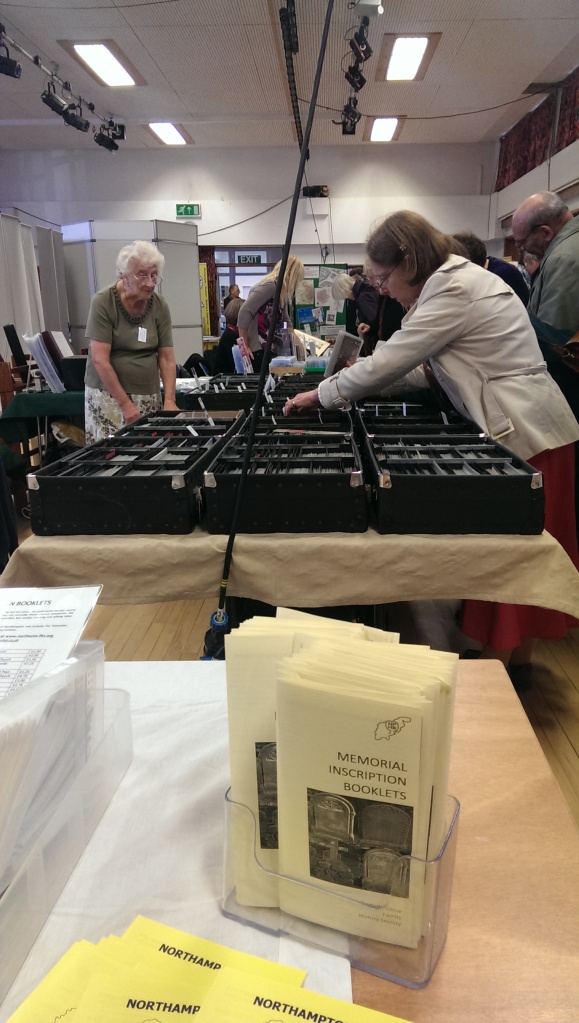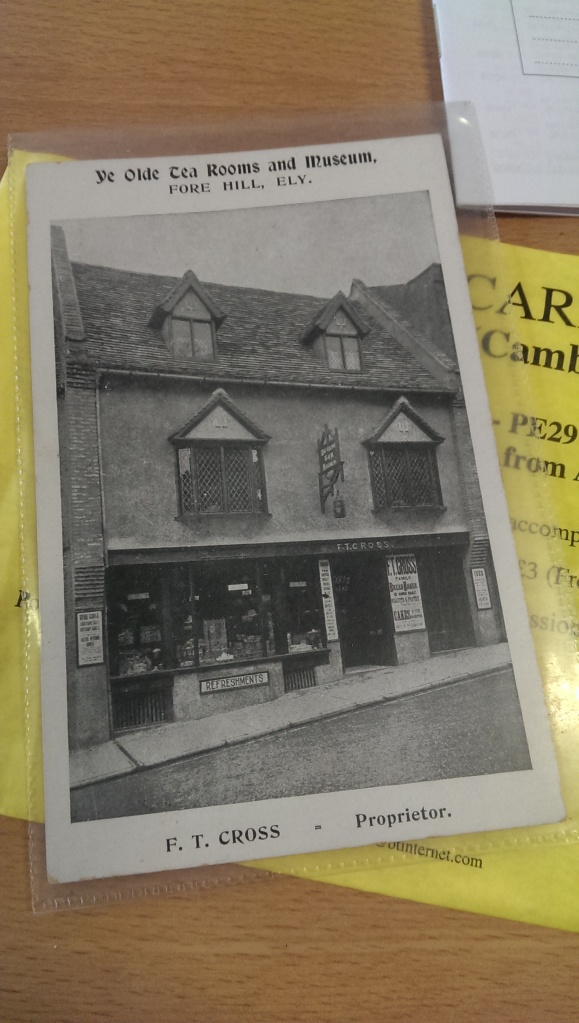Yesterday saw the second Cambridgeshire Family History Fair take place – a free genealogy and local history event held in Girton’s Glebe School on the north side of Cambridge.
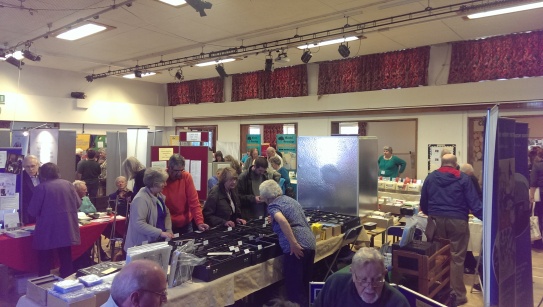
This year’s fair seemed much busier than last year, and although it seemed that there were fewer talks (one room, rather than two), this didn’t seem to affect the hustle and bustle in the main exhibition hall.
I went along for the whole day (10am-4pm), as I had my eye on 3 of the 4 expert talks, and also had a few genealogy hurdles that I wanted to try to resolve with the Suffolk Family History Society and the Norfolk Family History Society. I also hoped to bump into the postcard stall that I’d seen at last year’s fair… as I had a specific card to find.
Mike Petty MBE: Resources for Researching Cambridgeshire
My first talk of the day was the first time that I had attended a talk by Mike Petty MBE.
His fifty years of collectively working with the likes of The Cambridgeshire Collection, the Cambridgeshire Association for Local History (for which he is currently President), writing a weekly column for the Cambridge News, and being a seasoned lecturer and author for all things Cambridgeshire, has earned him an unrivalled knowledge of the history of the county, and the resources available to research it.
Mike admitted he’s not a genealogist – he’s a historian. This actually makes him a perfect speaker to genealogists, as his talk showed a full room how to get beyond the basics of censuses and BMDs, by digging out the more interesting information about Cambridgeshire that is tucked away in newspapers, in photographs, maps, and books.
As the audience were quickly scribbling down notes, Mike continued to show how to use online indexes to help make your next visit to a Cambridgeshire archives resource more time efficient. He spoke passionately about the vast card indexes that hold so many clues to resources, but which are themselves tucked away due to space limitations.
I’ll definitely make more effort to attend his talks in future – I feel like he could have talked for hours.
Postcard hunting
With a break between talks, I set myself off to see if I could find the Desira Postcards stall that I visited last year, and where I had bought one of two postcards of my Cross family’s bakery shop on Forehill, Ely.
Thankfully, the postcard I saw last year was still within their collection, so (ignoring the £8.50 price tag) I bought it, as it’s an example of how Frederick Thompson Cross was advertising his business. He died in 1911, after which his son Frederick Vernon Cross took over.
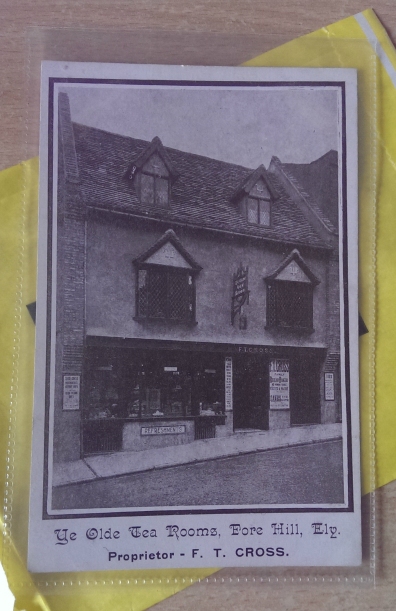
Carl Warner: Crowdsourcing History at IWM Duxford
Having enjoyed the collaborative crowdsourcing Lives Of The First World War project that IWM launched earlier this year, I was keen to see what Carl Warner (Imperial War Museum Duxford’s Research and Information Manager) was going to tell us about their Second World War project: American Air Museum.
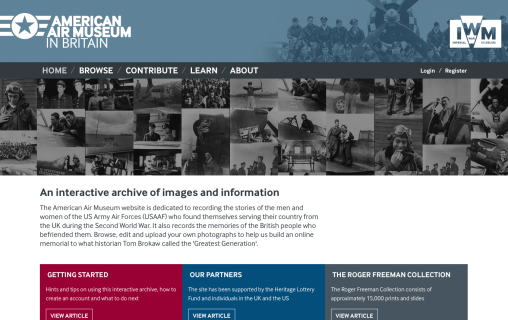
This time, Carl explained that IWM has just launched a new website containing around 15,000 photographs of the USAAF, and that members of the public can register and then add their own, whilst also discuss other images – in a hope to bring names to faces and places, and record the memories of those who remember the presence of American Airmen in Cambridgeshire during WWII.
My own Grandmother remembers the American airmen near Mepal, Cambridgeshire, and like many of her generation, it’s pretty much a story about eating ‘candy’ given to them. Little could she understand then as a child, that when she waved them off as they flew away, that many would never return.
Kathy Chater: How To Write Up Family History
Ex-BBC Researcher, turned professional genealogist, historian and author, Kathy Chater was my third and final expert speaker to listen in to. Her career background, like that of Richard Benson, would give me the impetus and expert advice I need to decide on how best to write up some of my own family history stories beyond the realms of this blog, and a characterless list of names and dates.
Kathy’s advice on breaking down your mountain of research into chunks and focussing on telling each piece of one person’s life at a time, certainly felt to me like a much easier approach. She then suggested that you could then weave a few of these into a story – trying to bring in national, international, social and family events to flesh out the stories and set your ancestor into context.
I’ve certainly been looking at how national and world events may have impacted on my relatives – looking at trends in silk and cotton weaving, the impact of the railways, enclosure acts, Cambridgeshire drainage acts, and of course the horror of wars.
Like Mike Petty, Kathy recommended turning to newspapers – not just the stories, but the adverts and reviews too – all which would help you to understand the world in which your relatives lived.
It was refreshing to hear Kathy give a shot of reality with her comments on being realistic about the publishing of the book – recommending that you should probably just stick to publishing it yourself within your family, and not a publisher. She amplified a message that I’ve heard regularly – file a copy of your book with relevant archives and organisations.
Recharged with enthusiasm to get stuck in to what was the 5th of my 5 New Year Genealogy Resolutions for 2014, I hope to at least be able to decide whether I’m going to aim for a novelised or non-fiction approach.
Another great genealogy fair!
I’d like to say thank you to all of the speakers that I saw, and also to the hard work of the Cambridgeshire Family History Society team who organised the event. It’s great to see this growing, and I look forward to next year’s event.

In the meantime, The Big Family History Fair organised by the Huntingdonshire Family History Society returns in May 2015.

